AtfA-Independent Adaptation to the Toxic Heavy Metal Cadmium in Aspergillus nidulans
Abstract
:1. Introduction
2. Materials and Methods
2.1. Strains and Culture Conditions
2.2. Recording Growth, Measuring GSH and GSSG Contents, 2′,7′-Dichlorofluorescein-Assay (DCF-Test)
2.3. Measuring Specific Enzyme Activities
2.4. Reverse-Transcription Quantitative Real-Time Polymerase Chain Reaction (RT-qPCR) Assays
2.5. High-Throughput RNA Sequencing
2.6. Evaluation of RNAseq Data
2.7. Promoter Analysis
3. Results
3.1. Deletion of atfA Did Not Alter Significantly the Physiology of CdCl2-Treated Cultures
3.2. Deletion of atfA Resulted in Marked Changes in Transcriptomes Observed under CdCl2 Stress
3.3. CdCl2 Stress Regulates Vegetative Growth, Cd2+ Efflux System, and Sulfur Metabolism in the Reference Strain
3.4. At the Level of Regulated Gene Groups, Deletion of atfA Caused Only Minor Changes in the Stress Response Induced by CdCl2
3.5. Background of the Differences Observed between the Stress Responses of the Two Strains
3.5.1. Diverging Gene Sets Regulate Same Biological Processes under Cadmium Stress
3.5.2. Differences between the Transcriptomes of Untreated Cultures Led to Different Stress Responses
3.5.3. Transcriptional Activities of Certain Genes Are Not Properly Regulated in the Absence of AtfA
3.5.4. Alternative Stress Response Elements Can Increase the Difference between the Stress Responses of the Two Strains
4. Discussion
4.1. Increased Cys Availability Is an Important Element of the CdCl2-Induced Stress Response
4.2. Adaptation to the Missing AtfA under Unstressed Conditions Influences Substantially the CdCl2 Induced Stress Response
Supplementary Materials
Author Contributions
Funding
Institutional Review Board Statement
Informed Consent Statement
Data Availability Statement
Conflicts of Interest
References
- Järup, L.; Akesson, A. Current status of cadmium as an environmental health problem. Toxicol. Appl. Pharmacol. 2009, 238, 201–208. [Google Scholar] [CrossRef] [PubMed]
- Godt, J.; Scheidig, F.; Grosse-Siestrup, C.; Esche, V.; Brandenburg, P.; Reich, A.; Groneberg, D.A. The toxicity of cadmium and resulting hazards for human health. J. Occup. Med. Toxicol. 2006, 1, 22. [Google Scholar] [CrossRef] [Green Version]
- Tchounwou, P.B.; Yedjou, C.G.; Patlolla, A.K.; Sutton, D.J. Heavy metal toxicity and the environment. Exp. Suppl. 2012, 101, 133–164. [Google Scholar] [PubMed] [Green Version]
- Tang, X.; Li, Q.; Wu, M.; Lin, L.; Scholz, M. Review of remediation practices regarding cadmium-enriched farmland soil with particular reference to China. J. Environ. Manag. 2016, 181, 646–662. [Google Scholar] [CrossRef]
- Abdel-Aty, A.M.; Ammar, N.S.; Abdel Ghafar, H.H.; Ali, R.K. Biosorption of cadmium and lead from aqueous solution by fresh water alga Anabaena sphaerica biomass. J. Adv. Res. 2013, 4, 367–374. [Google Scholar] [CrossRef] [PubMed] [Green Version]
- Chakraborty, S.; Mukherjee, A.; Khuda-Bukhsh, A.R.; Das, T.K. Cadmium-induced ox idative stress tolerance in cadmium resistant Aspergillus foetidus: Its possible role in cadmium bioremediation. Ecotoxicol. Environ. Saf. 2014, 106, 46–53. [Google Scholar] [CrossRef] [PubMed]
- Bano, A.; Hussain, J.; Akbar, A.; Mehmood, K.; Anwar, M.; Hasni, M.S.; Ullah, S.; Sajid, S.; Ali, I. Biosorption of heavy metals by obligate halophilic fungi. Chemosphere 2018, 199, 218–222. [Google Scholar] [CrossRef] [PubMed]
- Bakti, F.; Sasse, C.; Heinekamp, T.; Pócsi, I.; Braus, G.H. Heavy Metal-Induced Expression of PcaA Provides Cadmium Tolerance to Aspergillus fumigatus and Supports Its Virulence in the Galleria mellonella Model. Front. Microbiol. 2018, 9, 744. [Google Scholar] [CrossRef]
- Boczonádi, I.; Török, Z.; Jakab, Á.; Kónya, G.; Gyurcsó, K.; Baranyai, E.; Szoboszlai, Z.; Döncző, B.; Fábián, I.; Leiter, É.; et al. Increased Cd2+ biosorption capability of Aspergillus nidulans elicited by crpA deletion. J. Basic Microbiol. 2020, 60, 574–584. [Google Scholar] [CrossRef]
- Kurucz, V.; Kiss, B.; Szigeti, Z.M.; Nagy, G.; Orosz, E.; Hargitai, Z.; Harangi, S.; Wiebenga, A.; de Vries, R.P.; Pócsi, I.; et al. Physiological background of the remarkably high Cd2+ tolerance of the Aspergillus fumigatus Af293 strain. J. Basic Microbiol. 2018, 58, 957–967. [Google Scholar] [CrossRef]
- Banakar, R.; Alvarez Fernández, Á.; Abadía, J.; Capell, T.; Christou, P. The expression of heterologous Fe(III) phytosiderophore transporter HvYS1 in rice increases Fe uptake, translocation and seed loading and excludes heavy metals by selective Fe transport. Plant Biotechnol. J. 2016, 15, 423–432. [Google Scholar] [CrossRef] [Green Version]
- Hagiwara, D.; Asano, Y.; Yamashino, T.; Mizuno, T. Characterization of bZip-type transcription factor AtfA with reference to stress responses of conidia of Aspergillus nidulans. Biosci. Biotechnol. Biochem. 2008, 72, 2756–2760. [Google Scholar] [CrossRef] [Green Version]
- Balázs, A.; Pócsi, I.; Hamari, Z.; Leiter, É.; Emri, T.; Miskei, M.; Oláh, J.; Tóth, V.; Hegedűs, N.; Prade, R.A.; et al. AtfA BZIP-type transcription factor regulates oxidative and osmotic stress responses in Aspergillus nidulans. Mol. Genet. Genom. 2010, 283, 289–303. [Google Scholar] [CrossRef]
- Sakamoto, K.; Iwashita, K.; Yamada, O.; Kobayashi, K.; Mizuno, A.; Akita, O.; Mikami, S.; Shimoi, H.; Gomi, K. Aspergillus oryzae atfA controls conidial germination and stress tolerance. Fungal Genet. Biol. 2009, 46, 887–897. [Google Scholar] [CrossRef]
- Lara-Rojas, F.; Sánchez, O.; Kawasaki, L.; Aguirre, J. Aspergillus nidulans transcription factor AtfA interacts with the MAPK SakA to regulate general stress responses, development and spore functions. Mol. Microbiol. 2011, 80, 436–454. [Google Scholar] [CrossRef] [Green Version]
- Temme, N.; Oeser, B.; Massaroli, M.; Heller, J.; Simon, A.; Collado, I.G.; Viaud, M.; Tudzynski, P. BcAtf1, a global regulator, controls various differentiation processes and phytotoxin production in Botrytis cinerea. Mol. Plant Pathol. 2012, 13, 704–718. [Google Scholar] [CrossRef] [PubMed]
- Van Nguyen, T.; Kroger, C.; Bonnighausen, J.; Schäfer, W.; Bormann, J. The ATF/CREB transcription factor Atf1 is essential for full virulence, deoxynivalenol production, and stress tolerance in the cereal pathogen Fusarium graminearum. Mol. Plant. Microbe Interact. 2013, 26, 1378–1394. [Google Scholar] [CrossRef] [Green Version]
- Hagiwara, D.; Takahashi, H.; Kusuya, Y.; Kawamoto, S.; Kamei, K.; Gonoi, T. Comparative transcriptome analysis revealing dormant conidia and germination associated genes in Aspergillus species: An essential role for AtfA in conidial dormancy. BMC Genom. 2016, 17, 358. [Google Scholar] [CrossRef] [PubMed] [Green Version]
- Szabó, Z.; Pákozdi, K.; Murvai, K.; Pusztahelyi, T.; Kecskeméti, Á.; Gáspár, A.; Logrieco, A.F.; Emri, T.; Ádám, A.L.; Leiter, É.; et al. FvatfA regulates growth, stress tolerance as well as mycotoxin and pigment productions in Fusarium verticillioides. Appl. Microbiol. Biotechnol. 2020. [Google Scholar] [CrossRef]
- Nathues, E.; Joshi, S.; Tenberge, K.B.; von den Driesch, M.; Oeser, B.; Bäumer, N.; Mihlan, M.; Tudzynski, P. CPTF1, a CREB-like transcription factor, is involved in the oxidative stress response in the phytopathogen Claviceps purpurea and modulates ROS level in its host Secale cereale. Mol. Plant Microbe Interact. 2004, 17, 383–393. [Google Scholar] [CrossRef] [PubMed] [Green Version]
- Guo, M.; Guo, W.; Chen, Y.; Dong, S.; Zhang, X.; Zhang, H.; Song, W.; Wang, W.; Wang, Q.; Lv, R.; et al. The basic leucine zipper transcription factor Moatf1 mediates oxidative stress responses and is necessary for full virulence of the rice blast fungus Magnaporthe oryzae. Mol Plant Microbe Interact. 2010, 23, 1053–1068. [Google Scholar] [CrossRef] [Green Version]
- Pereira Silva, L.; Alves de Castro, P.; Dos Reis, T.F.; Paziani, M.H.; Von Zeska Kress, M.R.; Riaño-Pachón, D.M.; Hagiwara, D.; Ries, L.N.; Brown, N.A.; Goldman, G.H. Genome-wide transcriptome analysis of Aspergillus fumigatus exposed to osmotic stress reveals regulators of osmotic and cell wall stresses that are SakAHOG1 and MpkC dependent. Cell Microbiol. 2017, 19, e12681. [Google Scholar] [CrossRef]
- Emri, T.; Szarvas, V.; Orosz, E.; Antal, K.; Park, H.; Han, K.H.; Yu, J.H.; Pócsi, I. Core oxidative stress response in Aspergillus nidulans. BMC Genom. 2015, 16, 478. [Google Scholar] [CrossRef] [Green Version]
- Orosz, E.; Antal, K.; Gazdag, Z.; Szabó, Z.; Han, K.H.; Yu, J.H.; Pócsi, I.; Emri, T. Transcriptome-based modeling reveals that oxidative stress induces modulation of the AtfA-dependent signaling networks in Aspergillus nidulans. Int. J. Genomics. 2017, 2017, 6923849. [Google Scholar] [CrossRef] [PubMed]
- Antal, K.; Gila, B.C.; Pócsi, I.; Emri, T. General stress response or adaptation to rapid growth in Aspergillus nidulans? Fungal Biol. 2020, 124, 376–386. [Google Scholar] [CrossRef] [PubMed]
- Barratt, R.W.; Johnson, G.B.; Ogata, W.N. Wild-type and mutant stocks of Aspergillus nidulans. Genetics 1965, 52, 233–246. [Google Scholar] [CrossRef] [PubMed]
- Emri, T.; Pócsi, I.; Szentirmai, A. Glutathione metabolism and protection against oxidative stress caused by peroxides in Penicillium chrysogenum. Free. Radic. Biol. Med. 1997, 23, 809–814. [Google Scholar] [CrossRef]
- Emri, T.; Pócsi, I.; Szentirmai, A. Analysis of the oxidative stress response of Penicillium chrysogenum to menadione. Free. Radic. Res. 1999, 30, 125–132. [Google Scholar] [CrossRef]
- Anderson, M.E. Determination of glutathione and glutathione disulfide in biological samples. Methods Enzym. 1985, 113, 548–555. [Google Scholar]
- Sámi, L.; Emri, T.; Pócsi, I. Autolysis and aging of Penicillium chrysogenum cultures under carbon starvation: III: Glutathione metabolism and formation of reactive oxygen species. Mycol. Res. 2001, 105, 1246–1250. [Google Scholar] [CrossRef]
- Roggenkamp, R.; Sahm, H.; Wagner, F. Microbial assimilation of methanol induction and function of catalase in Candida boidinii. FEBS Lett. 1974, 41, 283–286. [Google Scholar] [CrossRef] [Green Version]
- Oberley, L.W.; Spitz, D.R. Assay of superoxide dismutase activity in tumor tissue. Methods Enzymol. 1984, 105, 457–464. [Google Scholar]
- Emri, T.; Bartók, G.; Szentirmai, A. Regulation of specific activity of glucose-6-phosphate-dehydrogenase and 6-phosphogluconate dehydrogenase in Penicillium chrysogenum. FEMS Microbiol. Lett. 1994, 117, 67–70. [Google Scholar] [CrossRef]
- Warrilow, A.G.; Hawkesford, M.J. Cysteine synthase (O-acetylserine (thiol) lyase) substrate specificities classify the mitochondrial isoform as a cyanoalanine synthase. J. Exp. Bot. 2000, 51, 985–993. [Google Scholar] [CrossRef] [Green Version]
- Pusztahelyi, T.; Pócsi, I.; Szentirmai, A. Ageing of Penicillium chrysogenum cultures under carbon starvation. II. Protease and N-acetyl—D-hexosaminidase production. Biotechnol. Appl. Biochem. 1997, 25, 87–93. [Google Scholar] [CrossRef]
- Chomczynski, P. A reagent for the single-step simultaneous isolation of RNA, DNA and proteins from cell and tissue samples. Bio. Techniques. 1993, 15, 536–537. [Google Scholar]
- Kovács, Z.; Szarka, M.; Kovács, S.; Boczonádi, I.; Emri, T.; Abe, K.; Pócsi, I.; Pusztahelyi, T. Effect of cell wall integrity stress and RlmA transcription factor on asexual development and autolysis in Aspergillus nidulans. Fungal Genet. Biol. 2013, 54, 1–14. [Google Scholar] [CrossRef]
- Kim, D.; Langmead, B.; Salzberg, S.L. HISAT: A fast spliced aligner with low memory requirements. Nat. Methods 2015, 12, 357–360. [Google Scholar] [CrossRef] [Green Version]
- Love, M.I.; Huber, W.; Anders, S. Moderated estimation of fold change and dispersion for RNA-seq data with DESeq2. Genome Biol. 2014, 15, 550. [Google Scholar] [CrossRef] [Green Version]
- Robinson, M.D.; McCarthy, D.J.; Smyth, G.K. EdgeR: A Bioconductor package for differential expression analysis of digital gene expression data. Bioinformatics 2010, 26, 139–140. [Google Scholar] [CrossRef] [PubMed] [Green Version]
- Clutterbuck, A.J. The genetics of conidiophore pigmentation in Aspergillus nidulans. J. Gen. Microbiol. 1990, 136, 1731–1738. [Google Scholar] [CrossRef] [Green Version]
- De Groot, P.W.; Brandt, B.W.; Horiuchi, H.; Ram, A.F.; de Koster, C.G.; Klis, F.M. Comprehensive genomic analysis of cell wall genes in Aspergillus nidulans. Fungal Genet. Biol. 2009, 46, S72–S81. [Google Scholar] [CrossRef] [Green Version]
- Flipphi, M.; Sun, J.; Robellet, X.; Karaffa, L.; Fekete, E.; Zeng, A.P.; Kubicek, C.P. Biodiversity and evolution of primary carbon metabolism in Aspergillus nidulans and other Aspergillus spp. Fungal Genet Biol. 2009, 46, S19–S44. [Google Scholar] [CrossRef]
- Inglis, D.O.; Binkley, J.; Skrzypek, M.S.; Arnaud, M.B.; Cerqueira, G.C.; Shah, P.; Wymore, F.; Wortman, J.R.; Sherlock, G. Comprehensive annotation of secondary metabolite biosynthetic genes and gene clusters of Aspergillus nidulans, A. fumigatus, A. niger and A. oryzae. BMC Microbiol. 2013, 13, 91. [Google Scholar] [CrossRef] [PubMed] [Green Version]
- Alcazar-Fuoli, L.; Mellado, E. Ergosterol biosynthesis in Aspergillus fumigatus: Its relevance as an antifungal target and role in antifungal drug resistance. Front Microbiol. 2013, 3, 439. [Google Scholar] [CrossRef] [Green Version]
- Antsotegi-Uskola, M.; Markina-Iñarrairaegui, A.; Ugalde, U. Copper Resistance in Aspergillus nidulans Relies on the PI-Type ATPase CrpA, Regulated by the Transcription Factor AceA. Front. Microbiol. 2017, 8, 912. [Google Scholar] [CrossRef]
- Benguella, B.; Benaissa, H. Cadmium removal from aqueous solutions by chitin: Kinetic and equilibrium studies. Water Res. 2002, 36, 2463–2474. [Google Scholar] [CrossRef]
- Bhanoori, M.; Venkateswerlu, G. In vivo chitin-cadmium complexation in cell wall of Neurospora crassa. Biochim. Biophys. Acta. 2000, 1523, 21–28. [Google Scholar] [CrossRef]
- Chatterjee, S.; Kumari, S.; Rath, S.; Priyadarshanee, M.; Das, S. Diversity, structure and regulation of microbial metallothionein: Metal resistance and possible applications in sequestration of toxic metals. Metallomics 2020, 12, 1637–1655. [Google Scholar] [CrossRef] [PubMed]
- Li, Z.S.; Lu, Y.P.; Zhen, R.G.; Szczypka, M.; Thiele, D.J.; Rea, P.A. A new pathway for vacuolar cadmium sequestration in Saccharomyces cerevisiae: YCF1-catalyzed transport of bis(glutathionato)cadmium. Proc. Natl. Acad. Sci. USA 1997, 94, 42–47. [Google Scholar] [CrossRef] [Green Version]
- Prévéral, S.; Gayet, L.; Moldes, C.; Hoffmann, J.; Mounicou, S.; Gruet, A.; Reynaud, F.; Lobinski, R.; Verbavatz, J.M.; Vavasseur, A.; et al. A common highly conserved cadmium detoxification mechanism from bacteria to humans: Heavy metal tolerance conferred by the ATP-binding cassette (ABC) transporter SpHMT1 requires glutathione but not metal-chelating phytochelatin peptides. J. Biol. Chem. 2009, 284, 4936–4943. [Google Scholar] [CrossRef] [Green Version]
- Le, Q.G.; Ishiwata-Kimata, Y.; Kohno, K.; Kimata, Y. Cadmium impairs protein folding in the endoplasmic reticulum and induces the unfolded protein response. FEMS Yeast Res. 2016, 16, fow049. [Google Scholar] [CrossRef] [Green Version]
- Oberegger, H.; Schoeser, M.; Zadra, I.; Abt, B.; Haas, H. SREA is involved in regulation of siderophore biosynthesis, utilization and uptake in Aspergillus nidulans. Mol. Microbiol. 2001, 41, 1077–1089. [Google Scholar] [CrossRef]
- Sato, I.; Shimizu, M.; Hoshino, T.; Takaya, N. The glutathione system of Aspergillus nidulans involves a fungus-specific glutathione S-transferase. J. Biol. Chem. 2009, 284, 8042–8053. [Google Scholar] [CrossRef] [PubMed] [Green Version]
- Kawasaki, L.; Aguirre, J. Multiple catalase genes are differentially regulated in Aspergillus nidulans. J. Bacteriol. 2001, 183, 1434–1440. [Google Scholar] [CrossRef] [PubMed] [Green Version]
- Thön, M.; Al-Abdallah, Q.; Hortschansky, P.; Brakhage, A.A. The thioredoxin system of the filamentous fungus Aspergillus nidulans: Impact on development and oxidative stress response. J. Biol. Chem. 2007, 282, 27259–27269. [Google Scholar] [CrossRef] [PubMed] [Green Version]
- Szilágyi, M.; Miskei, M.; Karányi, Z.; Lenkey, B.; Pócsi, I.; Emri, T. Transcriptome changes initiated by carbon starvation in Aspergillus nidulans. Microbiology 2013, 159, 176–190. [Google Scholar] [CrossRef] [Green Version]
- Gila CsB Moon, H.; Antal, K.; Hajdu, M.; Kovács, R.; Jónás, P.A.; Pusztahelyi, T.; Yu, J.H.; Pócsi, I.; Emri, T. DUG pathway governs degradation of intracellular glutathione in Aspergillus nidulans. Appl. Environ. Microbiol. 2021, 87, e01321-20. [Google Scholar] [CrossRef]
- Brzóska, M.M.; Moniuszko-Jakoniuk, J. Interactions between cadmium and zinc in the organism. Food Chem. Toxicol. 2001, 39, 967–980. [Google Scholar] [CrossRef]
- Zhang, D.; Liu, J.; Gao, J.; Shahzad, M.; Han, Z.; Wang, Z.; Li, J.; Sjölinder, H. Zinc supplementation protects against cadmium accumulation and cytotoxicity in Madin-Darby bovine kidney cells. PLoS ONE. 2014, 9, e103427. [Google Scholar] [CrossRef]
- Rossman, T.G.; Roy, N.K.; Lin, W.C. Is cadmium genotoxic? IARC Sci. Publ. 1992, 118, 367–375. [Google Scholar]
- Oberegger, H.; Zadra, I.; Schoeser, M.; Haas, H. Iron starvation leads to increased expression of Cu/Zn-superoxide dismutase in Aspergillus. FEBS Lett. 2000, 485, 113–116. [Google Scholar] [CrossRef] [Green Version]
- Nakagawa, C.W.; Yamada, K.; Mutoh, N. Role of Atf1 and Pap1 in the induction of the catalase gene of fission yeast Schizosaccharomyces pombe. J. Biochem. 2000, 127, 233–238. [Google Scholar] [CrossRef]
- Giaginis, C.; Gatzidou, E.; Theocharis, S. DNA repair systems as targets of cadmium toxicity. Toxicol. Appl. Pharmacol. 2006, 213, 282–290. [Google Scholar] [CrossRef] [PubMed]
- Beyersmann, D.; Hartwig, A. Carcinogenic metal compounds: Recent insight into molecular and cellular mechanisms. Arch. Toxicol. 2008, 82, 493–512. [Google Scholar] [CrossRef] [PubMed]
- Maret, W.; Moulis, J.M. The bioinorganic chemistry of cadmium in the context of its toxicity. Met. Ions Life Sci. 2013, 11, 1–29. [Google Scholar]
- Tamás, M.J.; Sharma, S.K.; Ibstedt, S.; Jacobson, T.; Christen, P. Heavy metals and metalloids as a cause for protein misfolding and aggregation. Biomolecules 2014, 4, 252–267. [Google Scholar] [CrossRef] [Green Version]
- Tamás, M.J.; Fauvet, B.; Christen, P.; Goloubinoff, P. Misfolding and aggregation of nascent proteins: A novel mode of toxic cadmium action in vivo. Curr. Genet. 2018, 64, 177–181. [Google Scholar] [CrossRef] [PubMed]
- Guelfi, A.; Azevedo, R.A.; Lea, P.J.; Molina, S.M. Growth inhibition of the filamentous fungus Aspergillus nidulans by cadmium: An antioxidant enzyme approach. J. Gen. Appl. Microbiol. 2003, 49, 63–73. [Google Scholar] [CrossRef] [Green Version]
- Tu, B.P.; Weissman, J.S. Oxidative protein folding in eukaryotes: Mechanisms and consequences. J. Cell Biol. 2004, 164, 341–346. [Google Scholar] [CrossRef]
- Rinnerthaler, M.; Büttner, S.; Laun, P.; Heeren, G.; Felder, T.K.; Klinger, H.; Weinberger, M.; Stolze, K.; Grousl, T.; Hasek, J.; et al. Yno1p/Aim14p, a NADPH-oxidase ortholog, controls extramitochondrial reactive oxygen species generation, apoptosis, and actin cable formation in yeast. Proc. Natl. Acad. Sci. USA 2012, 109, 8658–8663. [Google Scholar] [CrossRef] [Green Version]
- Todorova, D.; Nedeva, D.; Abrashev, R.; Tsekova, K. Cd (II) stress response during the growth of Aspergillus niger B 77. J. Appl. Microbiol. 2008, 104, 178–184. [Google Scholar] [CrossRef]
- Boczonádi, I.; Jakab, Á.; Baranyai, E.; Tóth, C.N.; Daróczi, L.; Csernoch, L.; Kis, G.; Antal, M.; Pusztahelyi, T.; Grawunder, A.; et al. Rare earth element sequestration by Aspergillus oryzae biomass. Environ. Technol. 2020, 16, 1–11. [Google Scholar] [CrossRef]
- Kapahi, M.; Sachdeva, S. Bioremediation options for heavy metal pollution. J. Health Pollut. 2019, 9, 191203. [Google Scholar] [CrossRef] [Green Version]
- Dusengemungu, L.; Kasali, G.; Gwanama, C.; Ouma, K.O. Recent advances in biosorption of copper and cobalt by filamentous fungi. Front Microbiol. 2020, 11, 582016. [Google Scholar] [CrossRef]
- Wysocki, R.; Tamás, M.J. How Saccharomyces cerevisiae copes with toxic metals and metalloids. FEMS Microbiol. Rev. 2010, 34, 925–951. [Google Scholar] [CrossRef] [PubMed] [Green Version]
- Fajardo-Somera, R.A.; Bowman, B.; Riquelme, M. The Plasma Membrane Proton Pump PMA-1 Is Incorporated into Distal Parts of the Hyphae Independently of the Spitzenkörper in Neurospora crassa. Eukaryot Cell 2013, 12, 1097–1105. [Google Scholar] [CrossRef] [PubMed] [Green Version]
- Lecchi, S.; Allen, K.E.; Pardo, J.P.; Mason, A.B.; Slayman, C.W. Conformational changes of yeast plasma membrane H(+)-ATPase during activation by glucose: Role of threonine-912 in the carboxy-terminal tail. Biochemistry 2005, 44, 16624–16632. [Google Scholar] [CrossRef] [PubMed]
- Façanha, A.L.; Appelgren, H.; Tabish, M.; Okorokov, L.; Ekwall, K. The endoplasmic reticulum cation P-type ATPase Cta4p is required for control of cell shape and microtubule dynamics. J. Cell Biol. 2002, 157, 1029–1039. [Google Scholar] [CrossRef] [PubMed] [Green Version]
- Cronin, S.R.; Rao, R.; Hampton, R.Y. Cod1p/Spf1p is a P-type ATPase involved in ER function and Ca2+ homeostasis. J. Cell Biol. 2002, 157, 1017–1028. [Google Scholar] [CrossRef] [Green Version]
- Vincent, K.; Wang, Q.; Jay, S.; Hobbs, K.; Rymond, B.C. Genetic interactions with CLF1 identify additional pre-mRNA splicing factors and a link between activators of yeast vesicular transport and splicing. Genetics 2003, 164, 895–907. [Google Scholar] [CrossRef] [PubMed]
- Oltra, E.; Verde, F.; Werner, R.; D’Urso, G. A novel RING-finger-like protein Ini1 is essential for cell cycle progression in fission yeast. J. Cell Sci. 2004, 117, 967–974. [Google Scholar] [CrossRef] [PubMed] [Green Version]
- Vernis, L.; El Banna, N.; Baïlle, D.; Hatem, E.; Heneman, A.; Huang, M.E. Fe-S Clusters Emerging as Targets of Therapeutic Drugs. Oxid. Med. Cell. Longev. 2017, 2017, 3647657. [Google Scholar] [CrossRef] [PubMed] [Green Version]
- Aung-Htut, M.T.; Ayer, A.; Breitenbach, M.; Dawes, I.W. Oxidative stresses and ageing. Subcell Biochem. 2012, 57, 13–54. [Google Scholar]

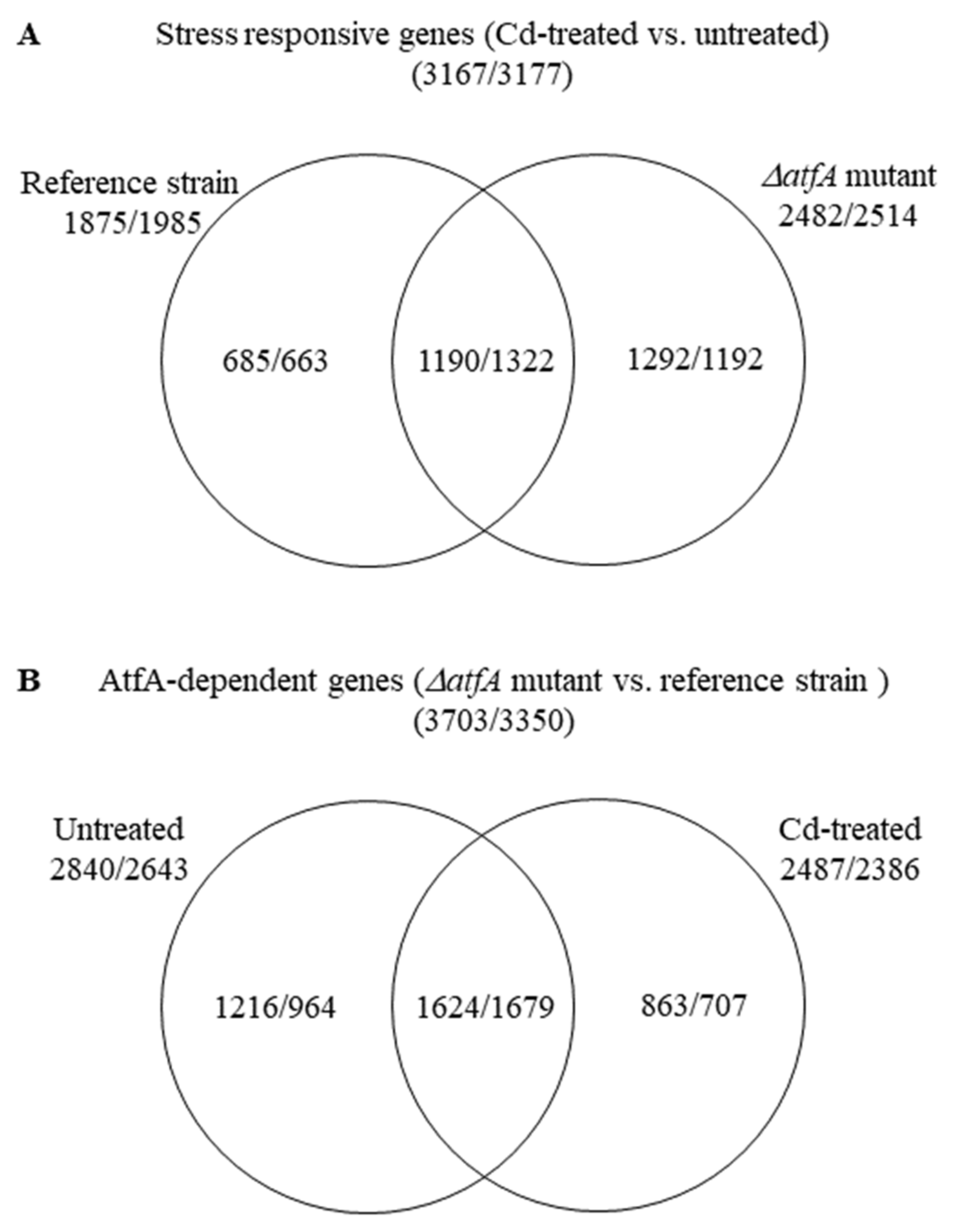
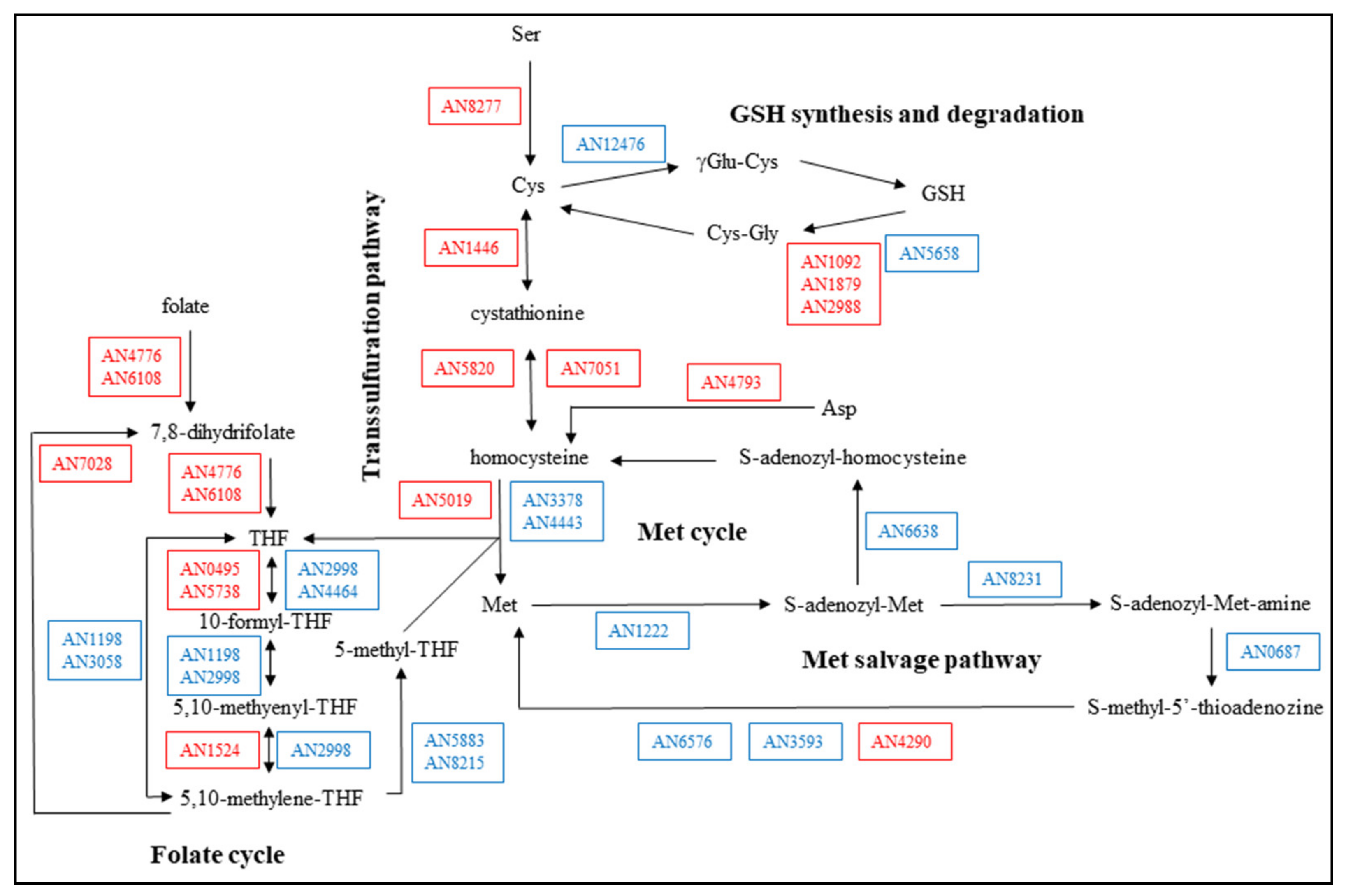
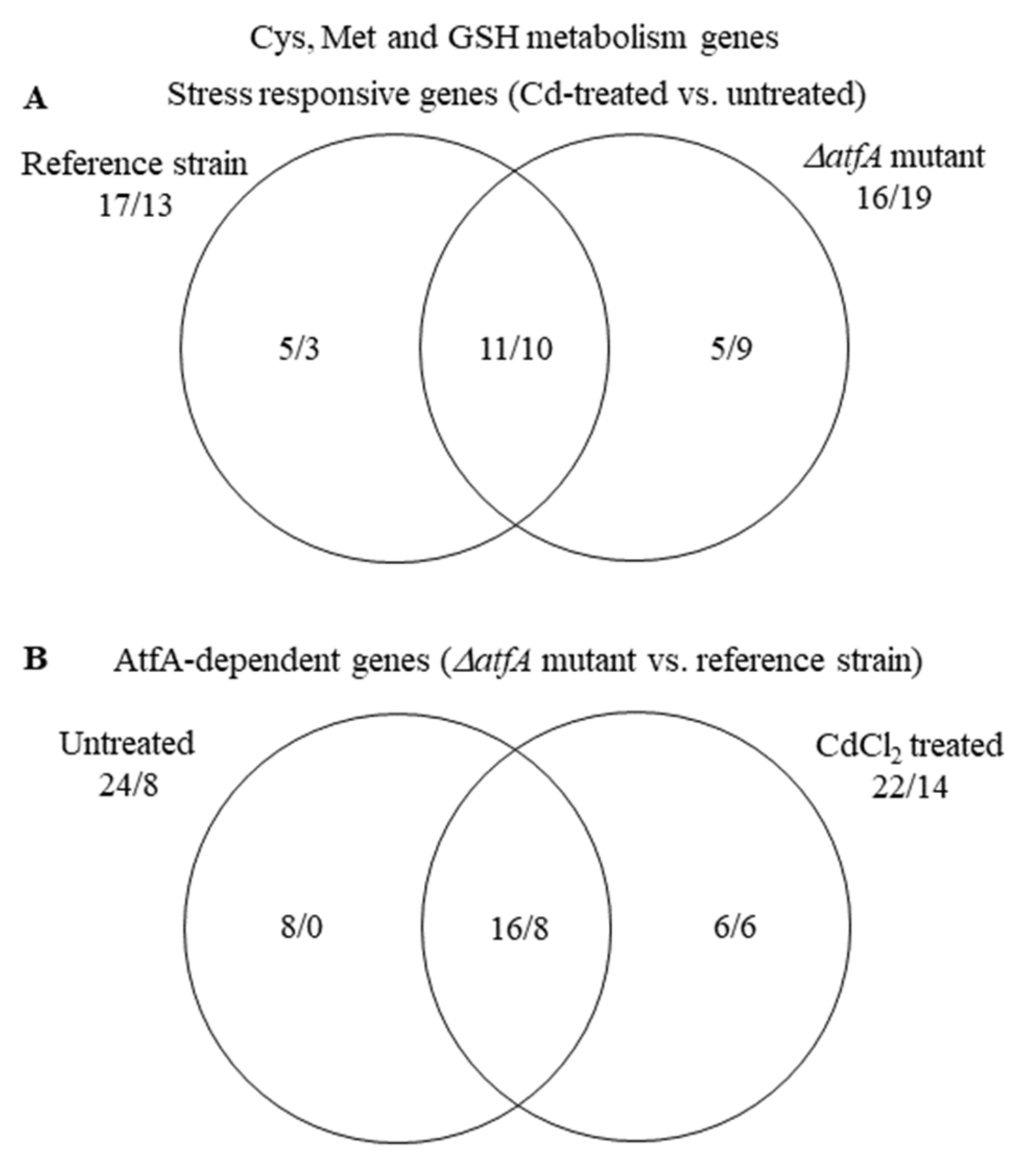
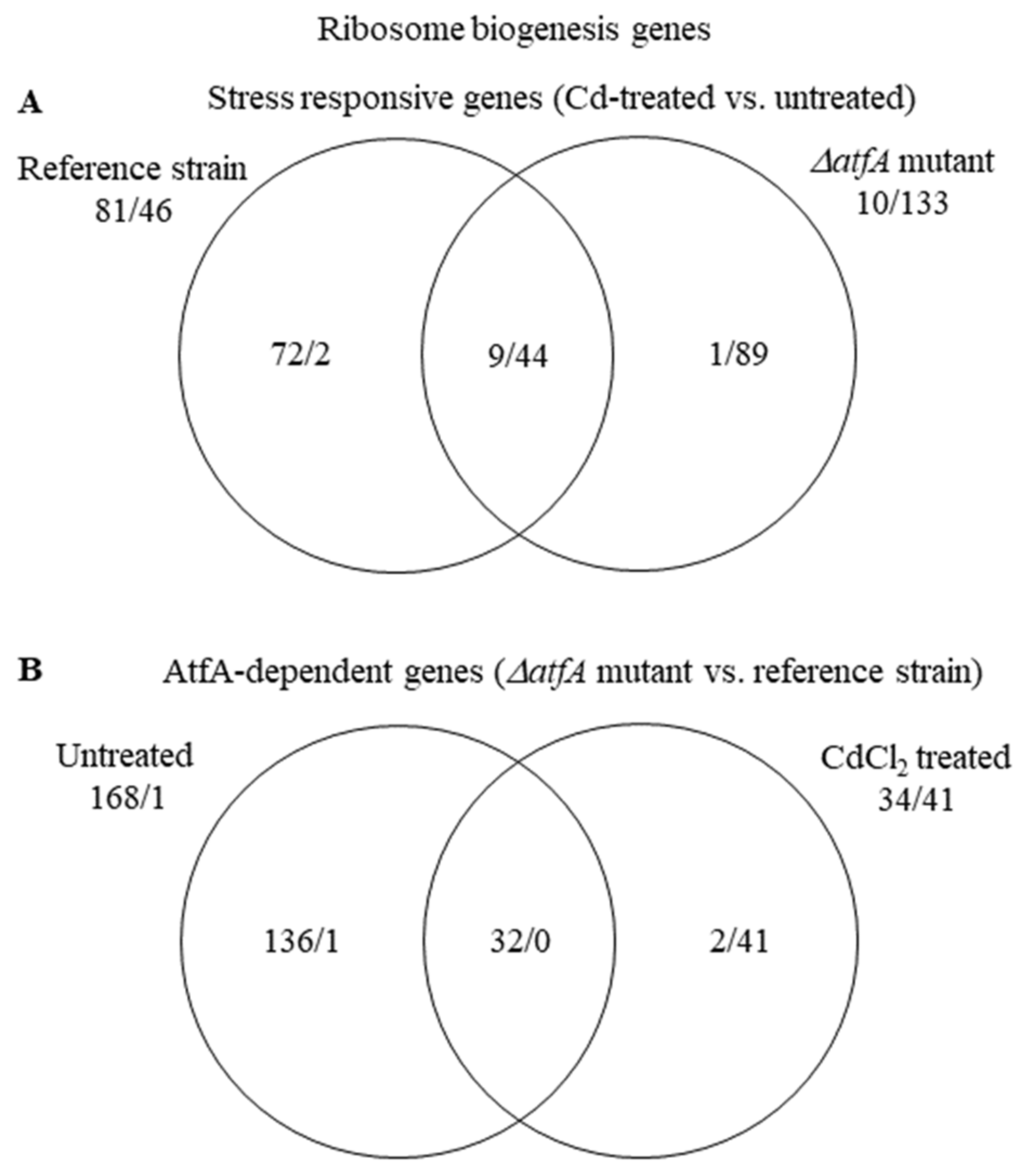
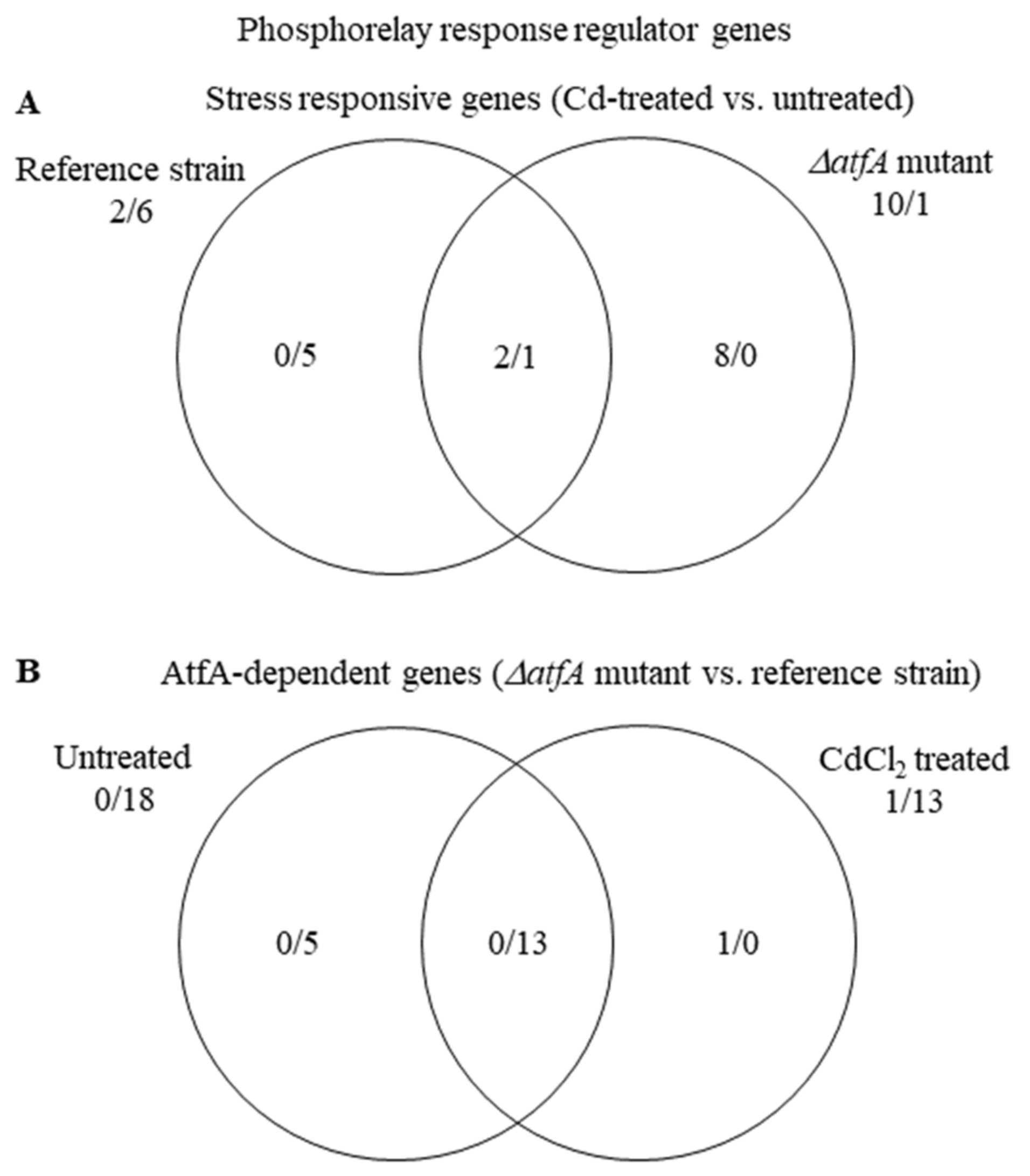


| THS30 Untreated | THS30 CdCl2 Treated | TNJ92 Untreated | TNJ92 CdCl2 Treated | |
|---|---|---|---|---|
| Catalase (kat/kg protein) | 4.2 ± 0.5 | 3.5 ± 0.4 | 1.3 ± 0.1 b | 1.2 ± 0.2 b |
| SOD (kU/kg protein) | 64 ± 11 | 138 ± 20 a | 73 ± 10 | 140 ± 18 a |
| Cys synthase (μKat/kg protein) | 55 ± 8 | 99 ± 15 a | 53 ± 12 | 95 ± 14 a |
| Chitinase (U/L) | <0.003 | <0.003 | <0.003 | 0.005 ± 0.003 a,b |
| N-Acetyl-β-D- -glucosaminidase (U/L) | 0.056 ± 0.012 | 0.059 ± 0.012 | 0.061 ± 0.010 | 0.041 ± 0.008 a,b |
| β-Glucosidase (U/L) | 0.08 ± 0.02 | 0.08 ± 0.01 | 0.14 ± 0.03 b | 0.15 ± 0.03 b |
| Number of Up- and Down-Regulated Genes | Significantly Enriched Terms a for | ||
|---|---|---|---|
| Up-Regulated Genes | Down-Regulated Genes | ||
| Reference strain, Cd treated vs. Reference strain, untreated | |||
| 1875 | 1985 | ribosome biogenesis (54), rRNA synthesis (30), mRNA processing (47), tRNA synthesis (20), aminoacyl-tRNA-synthetases (25), enoyl-CoA hydratase activity (4), obsolete ATP catabolic process (29), proteosomal degradation (76), stress response (92), nutrient starvation response (20), unfolded protein response (34), protein folding (18), protein processing in endoplasmic reticulum (33) | translation (90), ribosome biogenesis (70), purin nucleotide/nucleoside/nucleobase metabolism (39), glycolytic process (9), pyruvate metabolism (17), tricarboxylic-acid pathway (29), aerobic respiration (58), generation of precursor metabolites and energy (34), porphyrin and chlorophyll metabolism (11), Fe/S binding (24), C-1 compound catabolism (9), tetrahydrofolate interconversion (4) sterol metabolic process (14), acetyl-CoA carboxylase activity (5), biosynthesis of secondary metabolites (123), positive regulation of sterigmatocystin biosynthetic process (9) |
| ΔatfA mutant, Cd treated vs. ΔatfA mutant, untreated | |||
| 2482 | 2514 | aminoacyl-tRNA-synthetases (20), proteosomal degradation (88), stress response (114), nutrient starvation response (23), protein folding and stabilization (47), ER to Golgi transport (27), protein processing in endoplasmic reticulum (40), regulation of autophagy (8) | mitotic cell cycle (21), organization of chromosome structure (102), DNA synthesis and replication (73), mRNA synthesis (55), translation (120), ribosome biogenesis (144), deoxyribonucleotide metabolism (12), tricarboxylic-acid pathway (32), aerobic respiration (60), generation of precursor metabolites and energy (28), Fe/S binding (28), sterol metabolic process (17), acetyl-CoA carboxylase activity (5), one-carbon metabolic process (8), sulfate assimilation (8) |
| ΔatfA mutant, untreated vs. Reference strain, untreated | |||
| 2840 | 2643 | cytoskeleton (9), translation (138), ribosome biogenesis (158), protein folding and stabilization (64), N-directed glycosylation, deglycosylation (26), protein processing (proteolytic) (44), non-vesicular ER transport (8), unfolded protein response (35), Fe/S binding (26), aerobic respiration (61), purin nucleotide/nucleoside/nucleobase metabolism (54), pyrimidine metabolism (35), histidine metabolic process (11), sulfate assimilation (8), tetrahydrofolate-dependent C-1-transfer (11), G-protein mediated signal transduction (25) | development of asco- basidio- or zygospore (58), cell wall (78), glycolysis/gluconeogenesis (16), starch and sucrose metabolism (18), fructose and mannose metabolism (11), valine, leucine and isoleucine degradation (11), lipid/fatty acid transport (48), stress response (97), heat shock response (20), osmotic and salt stress response (35). two-component signal transduction system (16), MAPKKK cascade (16), non-ribosomal peptide synthesis (16), |
| ΔatfA mutant, Cd treated vs. Reference strain, Cd treated | |||
| 2487 | 2386 | cytoskeleton (8), N-directed glycosylation, deglycosylation (23), ER to Golgi transport (31), proteasomal degradation (ubiquitin/proteasomal pathway) (61), energy generation (e.g., ATP synthase)(13), amino acid metabolism (83), biosynthesis of methionine (12), biosynthesis of threonine (6), biosynthesis of vitamins, cofactors, and prosthetic groups (60), purine nucleotide/nucleoside/nucleobase anabolism (17) | development of asco- basidio- or zygospore (56), mitotic cell cycle (17), DNA synthesis and replication (44), organization of chromosome structure (77), DNA repair (74), osmosensing and response (30), two-component signal transduction system (12), MAPK signaling pathway–yeast (15) |
| Significantly Enriched Group a for | ||
|---|---|---|
| Up-Regulated Genes | Down-Regulated Genes | Stress Responsive/AtfA-Dependent Genes b |
| Reference strain, Cd treated vs. Reference strain, untreated | ||
| Ribosome biogenesis genes, Cys, Met and GSH metabolism genes, Folate cycle genes, Glycolysis genes, Autophagy related genes, ER to Golgi vesicle-mediated transport genes, inp cluster | Ribosome biogenesis genes, Cys rich proteins genes, Glyoxylate pathway genes, Folate cycle genes, Fe-S cluster assembly genes, Squalene-ergosterol pathway genes, Zinc transporter genes, Microperfuranone (mic) cluster, AN1242 cluster | Ribosome biogenesis genes, Glyoxylate pathway genes, Cys, Met and GSH metabolism genes, Folate cycle genes, Glycolysis genes, Fe-S cluster assembly genes, Squalene-ergosterol pathway genes |
| ΔatfA mutant, Cd treated vs. ΔatfA mutant, untreated | ||
| Autophagy related genes, ER to Golgi vesicle-mediated transport genes, Phosphorelay response regulator genes, inp cluster, AN7884 cluster, AN7084 cluster | Ribosome biogenesis genes, Squalene-ergosterol pathway genes, Zinc transporter genes, Glyoxylate pathway genes, Folate cycle genes, Fe-S cluster assembly genes, DNA repair, Microperfuranone (mic) cluster | Ribosome biogenesis genes, Autophagy related genes, Zinc transporter genes, Cell wall biosynthesis, Glyoxylate pathway genes, Cys, Met and GSH metabolism genes, Fe-S cluster assembly genes |
| ΔatfA mutant, untreated vs. Reference strain, untreated | ||
| Ribosome biogenesis genes, Cys, Met and GSH metabolism genes, Folate cycle genes, Fe-S cluster binding protein genes, Antioxidant enzyme genes, ER to Golgi vesicle-mediated transport genes, AN6236 cluster, Penicillin cluster, xptA-containing cluster | Cell wall biosynthesis and degradation, Cell wall biosynthesis, Chitin synthesis, Cell wall integrity pathway genes, Autophagy related genes, Phosphorelay response regulator genes, Glycolysis genes, AN7084 cluster, AN10486 cluster, AN3612 cluster, AN12331 cluster, No PKS/NRPS backbone cluster 1, AN2924 cluster, AN1594 cluster, AN9005 cluster, Emericellamide (eas) cluster | Ribosome biogenesis genes, Cell wall biosynthesis, Antioxidant enzyme genes, Phosphorelay response regulator genes, Glycolysis genes |
| ΔatfA mutant, Cd treated vs. Reference strain, Cd treated | ||
| Cys, Met and GSH metabolism genes, Antioxidant enzyme genes, ER to Golgi vesicle-mediated transport genes, Glycolysis genes, AN6236 cluster, AN8504 cluster, No PKS/NRPS backbone cluster 3, xptA-containing cluster | Cell wall biosynthesis and degradation, Cell wall biosynthesis, Chitin synthesis, Glyoxylate pathway genes, “Excision repair” genes, Secondary metabolite cluster key genes, Phosphorelay response regulator genes, pkb cluster, AN7084 cluster, AN2924 cluster, AN9005 cluster, Emericellamide (eas) cluster, AN9314 cluster | Chitin synthesis, Cys, Met and GSH metabolism genes, Antioxidant enzyme genes, Phosphorelay response regulator genes |
| Number of | Gene Group a | ||||||
|---|---|---|---|---|---|---|---|
| A | B | C | D | E | F | G | |
| Genes | 20 | 21 | 5 | 21 | 16 | 13 | 9 |
| Genes with binding site | 12 (E–G) b | 7 (G) b | 2 | 7 (G) b | 3 | 2 | 0 |
| Binding sites | 20 (D–G) c | 10 | 2 | 8 | 3 | 2 | 0 |
Publisher’s Note: MDPI stays neutral with regard to jurisdictional claims in published maps and institutional affiliations. |
© 2021 by the authors. Licensee MDPI, Basel, Switzerland. This article is an open access article distributed under the terms and conditions of the Creative Commons Attribution (CC BY) license (https://creativecommons.org/licenses/by/4.0/).
Share and Cite
Emri, T.; Gila, B.; Antal, K.; Fekete, F.; Moon, H.; Yu, J.-H.; Pócsi, I. AtfA-Independent Adaptation to the Toxic Heavy Metal Cadmium in Aspergillus nidulans. Microorganisms 2021, 9, 1433. https://doi.org/10.3390/microorganisms9071433
Emri T, Gila B, Antal K, Fekete F, Moon H, Yu J-H, Pócsi I. AtfA-Independent Adaptation to the Toxic Heavy Metal Cadmium in Aspergillus nidulans. Microorganisms. 2021; 9(7):1433. https://doi.org/10.3390/microorganisms9071433
Chicago/Turabian StyleEmri, Tamás, Barnabás Gila, Károly Antal, Fanni Fekete, Heungyun Moon, Jae-Hyuk Yu, and István Pócsi. 2021. "AtfA-Independent Adaptation to the Toxic Heavy Metal Cadmium in Aspergillus nidulans" Microorganisms 9, no. 7: 1433. https://doi.org/10.3390/microorganisms9071433
APA StyleEmri, T., Gila, B., Antal, K., Fekete, F., Moon, H., Yu, J.-H., & Pócsi, I. (2021). AtfA-Independent Adaptation to the Toxic Heavy Metal Cadmium in Aspergillus nidulans. Microorganisms, 9(7), 1433. https://doi.org/10.3390/microorganisms9071433








